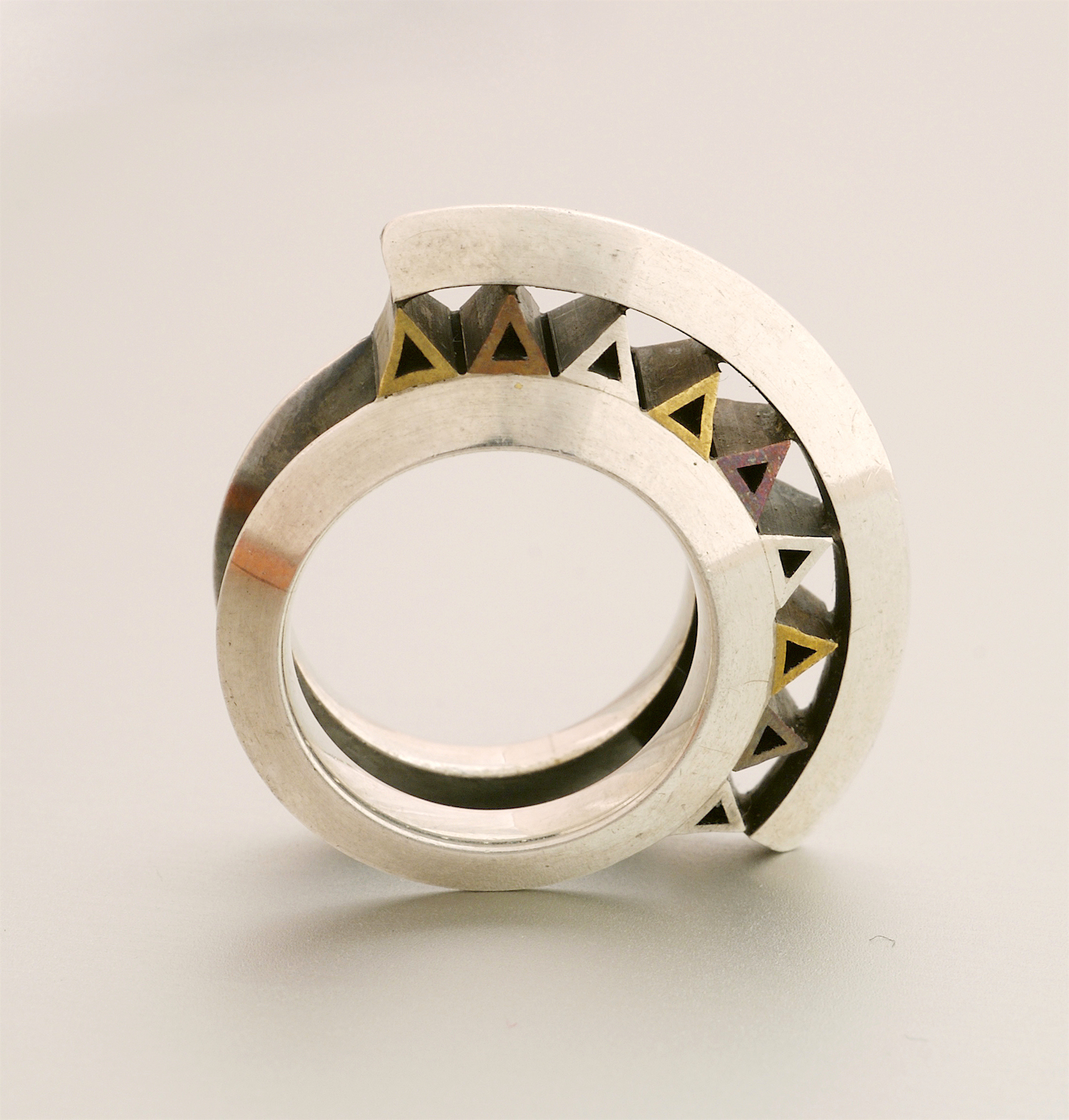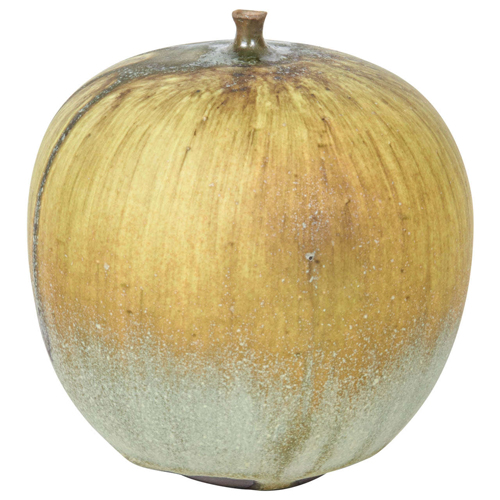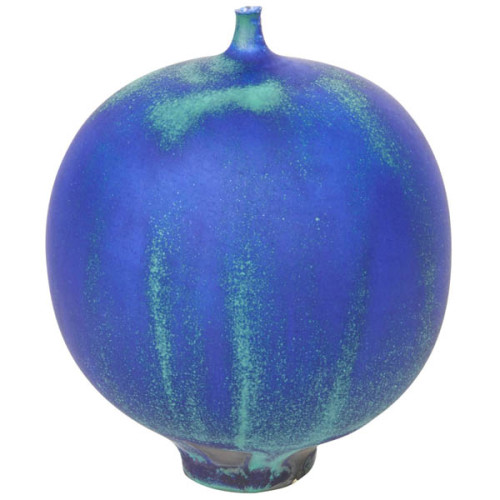Studio
-
Rose Cabat/American Studio Ceramics Rare “Feelie” Porcelain Vessel, c. 1980-85
ROSE CABAT (1914-2015) USA
Rare and important large scale “Feelie” c. 1980-85
Thin walled porcelain vessel with a silky satiny matte drip glaze
Signed: incised CABAT on bottom
For more information on Rose Cabat see: Rose Erni Cabat Retrospective 1936-1986 (Tuscon, AZ: Tuscon Museum of Art, 1986)
H: 3 5/8″
Price: $1,650
Rose Cabat was an American studio ceramicist living in Tucson. Considered one of the most important ceramic artists of the Mid-century Modernist movement, Cabat is best known for her innovative glazes on small porcelain pots called “feelies” which she developed in the 1960s. Her organic forms often resemble the shape of onions and figs, and her glazes range from organic to jewel tones. Cabat was born in 1914 in the Bronx, New York, began to work in ceramics in the late 1930′s, and moved to Arizona in 1942, where she continued to make innovative ceramics.
Feelies:
Feelies are described as onion, fig, cucumber, and saucer-shaped ceramic vases terminating in an upward closed neck. Bruce Block, an avid collector, has described them as sensual and tactile with a very specific unforgettable texture, spiritual seeming to contain a type of energy. Rose Cabat had developed a silky satiny glaze, and it wasn’t until around 1960 that she had hit upon the first of the appropriate form, svelte and sleek to match the glaze. She exclaimed, “Now this one’s a feelie.”, coining the term. Upon developing the new glazes, she felt that she needed new forms to apply the glazes to, different from what she made before, “craft fair” style coiled heads and wind bells. She is quoted as saying, “The old things did not look good … I wanted simpler shapes that went with the glazes.”They are typically globular in shape, tightening down to a minuscule neck glazed to a satin surface. The tactile experience is most important. The nature of the neck is such that it is closed, so narrow that it cannot hold anything. Cabat would reply when asked why the necks of her feelies are so narrow, “A vase can hold weeds or flowers, but can’t it just be a spot of beauty?” -
Robert Schellin American Studio Pottery Hand Thrown Floor Vase 1958
ROBERT SCHELLIN (1910 – 1985) USA
“Calligraphy” Floor Vase 1958
Hand thrown earthenware with a light and dark brown glaze with a stylized abstract calligraphic motif encircling the body
Marks: various marks and estate stamps Robert Schellin, Made in 1958, P88, C118 (paper labels)
For more information see: Schellin, A Retrospective (Milwaukee: School of Fine Arts, The University of Wisconsin, 1975); Who Was Who in American Art, (Madison, Conn.: Sound View Press, 1985), p. 547.
H: 23 1/2″ x Dia: 7″
Price: $9,000
Robert Schellin’s life as an artist was consistent, productive, and based on firm philosophical foundations. Regarding his own progress, he had always been aware, as a young art student and later as a mature artist, that deliberately narrowing the focus of his interests to assure a more constant public notice would run the risk of his becoming highly expert, but sterile in expression. From the beginning of art student days Schellin moved from very satisfying periods of drawing and painting to work in three-dimensional
Media, frequently in the medium of ceramics.Schellin left the W.P.A. in 1937 to teach at the University of Wisconsin in Milwaukee. After a year he moved to East Orange, New Jersey, supervising art in the public schools. It was during this stay in the New York metropolitan area that he studied with Hans Hoffmann at his Eighth Street School and witnessed at first hand the changing art scene and the growing commercialism of the artists market. Robert Schellin later returned back to Milwaukee rejoining the faculty of the University of Wisconsin (UWM). His works have been exhibited for many years in Wisconsin and national shows including the Wisconsin State Fair; the Art Institute of Chicago, 1944; the Walker Art Center, Minneapolis, 1946; and the Milwaukee Art Institute numerous times between 1939-1960. He was included in the USIA European Traveling exhibition 1959-61.
-
Rose Cabat / American Studio Ceramics “Feelie” Porcelain Vessel, c. 1980-85
ROSE CABAT (1914-2015) USA
“Feelie” c. 1980-85
Thin walled porcelain vessel with a silky satiny matte drip glaze
Signed: incised CABAT on bottom
For more information on Rose Cabat see: Rose Erni Cabat Retrospective 1936-1986 (Tuscon, AZ: Tuscon Museum of Art, 1986)
H: 4 3/4″
Price: $2,500
Rose Cabat is an American studio ceramicist living in Tucson. Considered one of the most important ceramic artists of the Mid-century Modernist movement, Cabat is best known for her innovative glazes on small porcelain pots called “feelies” which she developed in the 1960s. Her organic forms often resemble the shape of onions and figs, and her glazes range from organic to jewel tones. Cabat was born in 1914 in the Bronx, New York, began to work in ceramics in the late 1930′s, and moved to Arizona in 1942, where she continued to make innovative ceramics.
Feelies:
Feelies are described as onion, fig, cucumber, and saucer-shaped ceramic vases terminating in an upward closed neck. Bruce Block, an avid collector, has described them as sensual and tactile with a very specific unforgettable texture, spiritual seeming to contain a type of energy. Rose Cabat had developed a silky satiny glaze, and it wasn’t until around 1960 that she had hit upon the first of the appropriate form, svelte and sleek to match the glaze. She exclaimed, “Now this one’s a feelie.”, coining the term. Upon developing the new glazes, she felt that she needed new forms to apply the glazes to, different from what she made before, “craft fair” style coiled heads and wind bells. She is quoted as saying, “The old things did not look good … I wanted simpler shapes that went with the glazes.”They are typically globular in shape, tightening down to a minuscule neck glazed to a satin surface. The tactile experience is most important. The nature of the neck is such that it is closed, so narrow that it cannot hold anything. Cabat would reply when asked why the necks of her feelies are so narrow, “A vase can hold weeds or flowers, but can’t it just be a spot of beauty?” -
Wilhelm Kage / Gustavsberg “Nude” Farsta Studio Bowl c. 1940
WILHELM KÅGE (1889-1960) Sweden
GUSTAVSBERG Gustavsberg, Sweden
“Nude” Farsta bowl c. 1940
Glazed stoneware with hand inscribed sgraffito decoration of a nude
Marks: Kage, Studio Gustavsberg; FARSTA
Dia: 8″
Originally a painter, Wilhelm Kåge was employed by Gustavsberg as an art director to rejuvenate the pottery´s production. He was faithful to the company for 32 years. In 1942 he started the legendary Gustavsberg Studio with the mission to create unique artistic pieces. His lively imagination brought forth a great variety of forms. Kåge was an artist of contradictions. In the 1940´s and 50´s he designed several geometrical, almost cubist, vessels in the “Surrea” series which stands in striking contrast to his soft formed, organic shaped tableware from the same period. Kåge designed more than 30 different dinner services, of particular importance was the inexpensive “workers” service, intended for a wider audience. Kåge´s pride, however, was the Farsta series of unique vessels made of heavy stoneware with carved surfaces and earth coloured decorative glazes. The clay for which was taken from the Farsta bay area very near the Gustavsberg pottery. He began experimenting with the Farsta line of studio ceramics already in the 1920´s. Art historians and collectors today consider the Farsta pieces the culmination of Wilhelm Kåge´s artistic production. -
Margaret Postgate / Cowan Pottery Studio American Art Deco Cubist Elephant bookends c. 1929
MARGARET POSTGATE (1879-1953) USA
WAYLANDE GREGORY (1905-1971) USA
ARTHUR BAGGS (1886-1947) (glaze development) USA
COWAN POTTERY STUDIO USA
Cubist Elephant bookends 1929
Ceramic bookends with a black gunmetal glaze
Signed: Cowan studio mark (under glaze) Cowan bookend numbers 840 and 841
For more information and illustration see: Cowan Pottery and the Cleveland School, by Mark Bassett and Victoria Naumann (Atglen, PA: Schiffer, 1997).
H: 4 1/2″ x W: 5 1/2” x D: 3 3/4”
Margaret J. Postgate was born in Chicago, IL on September 29, 1879 and died at a hospital in the Bronx, NY in 1953. Her family moved to Manhattan around 1910 and then Brooklyn around 1925 and she remained a Brooklyn resident right up until her death. Her parents were both born in England: John W. Postgate and Margaret Postgate nee Derry. She had siblings, a brother George and one or two sisters, Mary and/or Mae. Margaret studied at the Art Institute of Chicago and Cooper Union School of Art in New York. In 1925, 1925, and 1926 she participated in soap sculpture carving competitions, some sponsored by Procter & Gamble Corporation in Cincinnati, Ohio. Pamphlets exist as well as exhibition brochures and others on “how-to” carving penned by Postgate. Margaret Postgate designed for Cowan from 1929-1930 where she adapted a few of the designs she had rendered in soap for ceramic sculptures for the Cowan Pottery. She also executed a few pieces of sculpture that were cast in bronze for the bronze division of the Gorham Manufacturing Company.







